Thai desserts offer a unique blend of flavors and textures that will delight your taste buds. These sweet treats showcase the rich culinary traditions of Thailand, often featuring ingredients like coconut, mango, and sticky rice.
You’ll find a wide variety of Thai desserts to satisfy your sweet tooth, from creamy puddings to colorful jellies.
When you try Thai desserts, you’ll experience a balance of sweet, salty, and sometimes savory elements that make them stand out from Western sweets. Many Thai desserts are easy to make at home, allowing you to bring a taste of Thailand to your own kitchen.
Get ready to explore 21 delicious Thai desserts that will expand your dessert horizons.
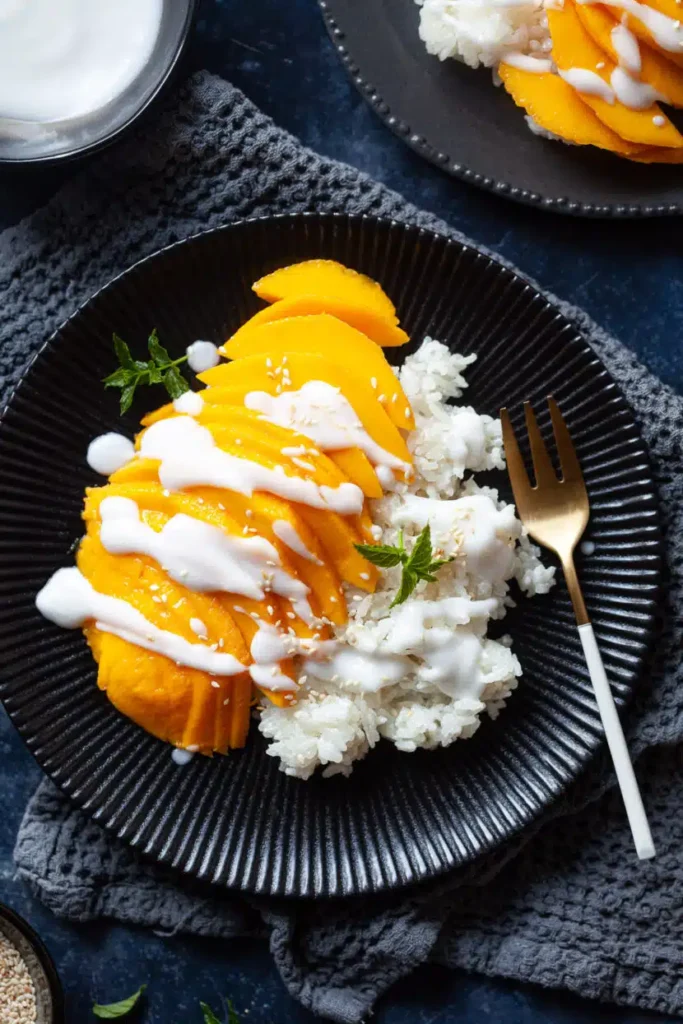
1. Mango Sticky Rice
Mango sticky rice, or Khao Niaow Ma Muang, is a beloved Thai dessert. You’ll find it made with sweet glutinous rice, ripe mangoes, and coconut milk.
The rice is steamed and then soaked in sweetened coconut milk. This gives it a creamy texture and rich flavor.
Fresh mango slices are served alongside the rice.
You can make this treat at home. Steam the sticky rice with pandan leaves for extra aroma. Then mix it with warm coconut milk and sugar. Let it sit to absorb the flavors.
Serve the sticky rice with slices of juicy mango. Pour some extra coconut sauce on top for added sweetness. This dessert is perfect for hot days or as a light after-dinner treat.

2. Tub Tim Krob
Tub Tim Krob is a refreshing Thai dessert that’ll catch your eye with its vibrant red color. The name means “crunchy rubies” in Thai, and it’s easy to see why.
The dessert features water chestnuts coated in tapioca flour, giving them a ruby-like appearance. These “rubies” are then served in a sweet coconut milk sauce over crushed ice.
You’ll love the mix of textures in this treat. The water chestnuts provide a satisfying crunch, while the coconut milk adds a smooth, creamy element.
To make Tub Tim Krob, you’ll need water chestnuts, tapioca flour, red food coloring, coconut milk, and sugar. It’s a simple yet impressive dessert that’s perfect for hot days.
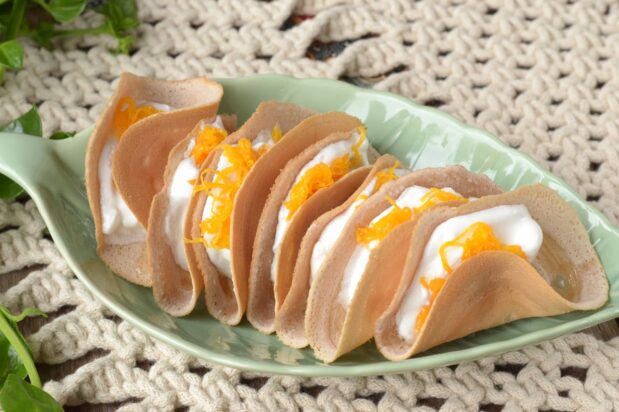
3. Khanom Buang
Khanom Buang is a popular Thai street snack that resembles a crispy pancake or crepe. You’ll find these delightful treats sold by vendors across Thailand, especially in Bangkok.
These sweet pancakes have a rich history dating back to the Ayutthaya period. Some people say they look a bit like Mexican tacos.
When you try Khanom Buang, you’ll enjoy a crispy shell filled with sweet or savory ingredients. Common fillings include coconut cream, shredded coconut, and egg threads.
You can easily find these treats at food courts, night markets, and floating markets in Thailand. A set of Khanom Buang typically costs around 30-35 baht.
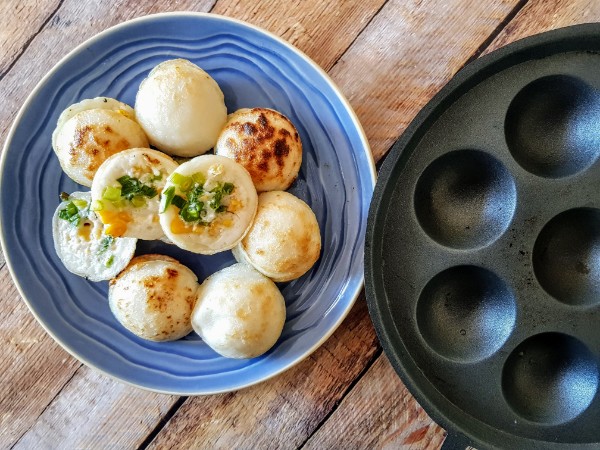
4. Khanom Krok
Khanom Krok is a popular Thai coconut pancake dessert. You’ll love these small, crispy treats with their soft, creamy centers.
To make Khanom Krok, you mix rice flour, coconut milk, sugar, and salt. Some recipes add cooked jasmine rice for extra texture.
The batter is cooked in special pans with half-sphere molds. This gives the pancakes their unique round shape.
As they cook, the outside becomes crispy while the inside stays smooth and pudding-like. You can add toppings like corn or green onions for extra flavor.
Khanom Krok is best enjoyed fresh and warm. You’ll find these sweet bites sold by street vendors all over Thailand.
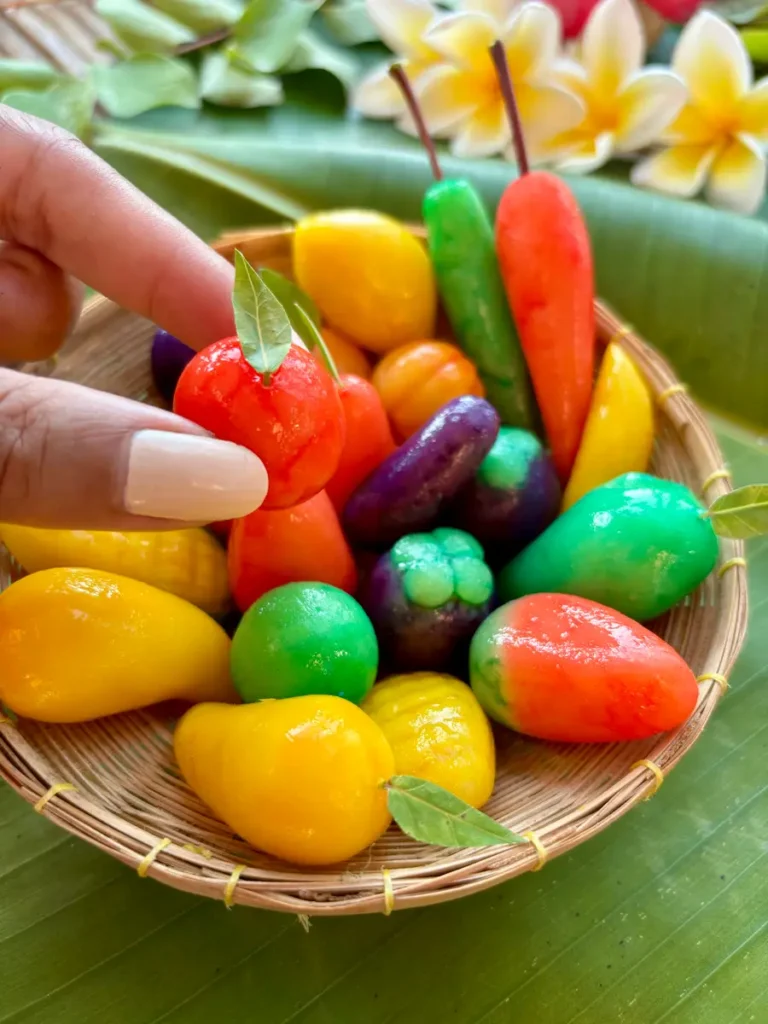
5. Luk Chup
Luk Chup is a charming Thai dessert that will catch your eye. These tiny treats look like miniature fruits and vegetables.
You’ll find them made from mung beans, sugar, and coconut milk. The mixture is shaped into small fruit or veggie forms.
Each piece gets a coating of agar agar jelly. This gives them a shiny, glossy look. The result is a sweet and creamy bite-sized dessert.
You can enjoy Luk Chup in various shapes. Common ones include chilies, oranges, mangoes, and bananas. They’re as fun to look at as they are to eat.
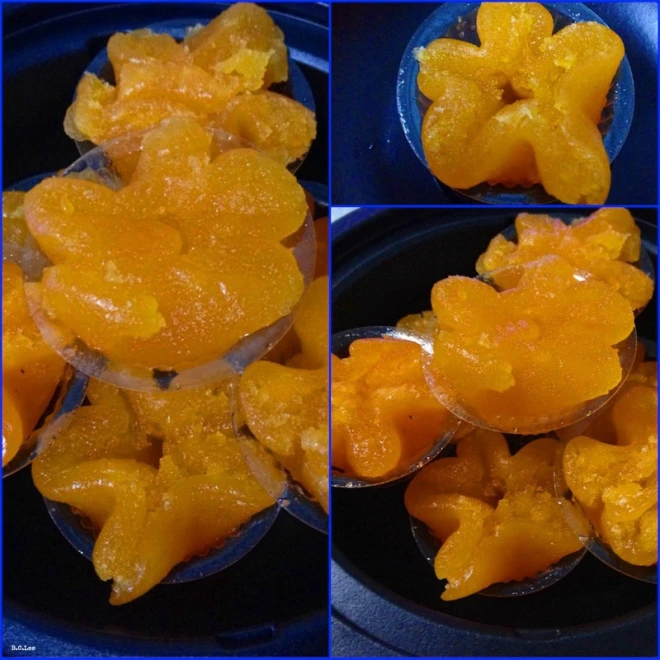
6. Thong Yip
Thong yip is a traditional Thai dessert that symbolizes prosperity and success. You’ll recognize it by its golden color and flower-like shape.
This sweet treat is made from egg yolks, sugar, and jasmine-flavored water. Duck and chicken eggs are often used to create its rich texture.
Thong yip is part of Thailand’s nine auspicious desserts. You’ll often see it at special events like weddings. Its golden hue represents wealth and good fortune.
When you taste thong yip, you’ll enjoy its smooth, sweet flavor. It’s a small but meaningful part of Thai culinary culture.
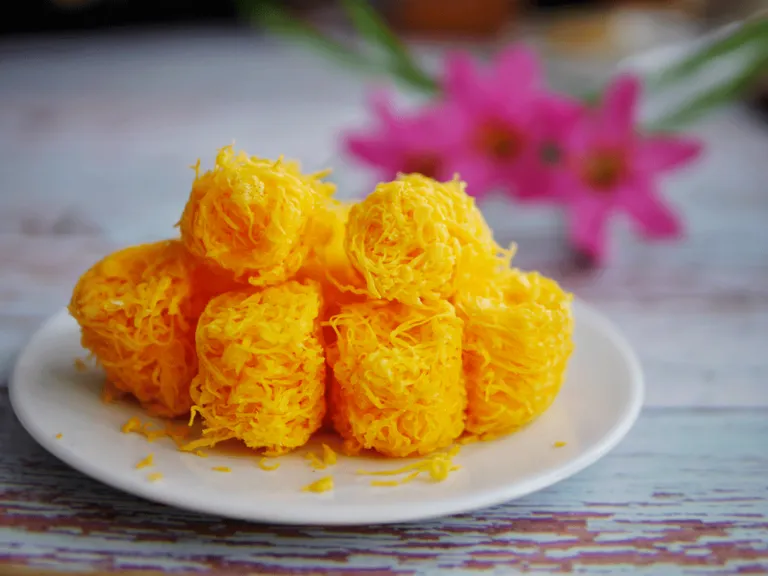
7. Foi Thong
Foi Thong is a popular Thai dessert that looks like golden threads. It’s made by drizzling egg yolks into hot sugar syrup.
The name “Foi Thong” means “golden threads” in Thai. Duck egg yolks are often used to create this sweet treat.
To make Foi Thong, you pour the egg yolks through a small funnel into boiling syrup. This creates long, delicate strands.
Pandan leaves are added to the syrup for extra flavor. The result is a sweet, stringy dessert with a unique texture.
You can find Foi Thong sold in many places across Thailand. It’s a common sight at markets and dessert shops.
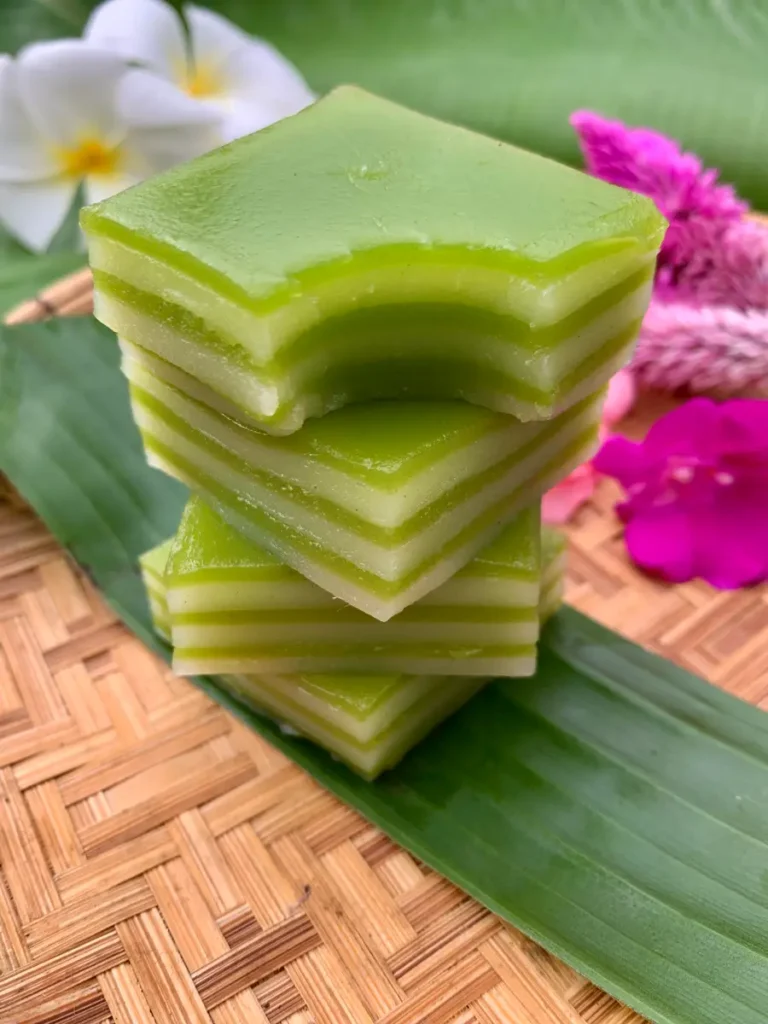
8. Khanom Chan
Khanom Chan is a popular Thai dessert that catches your eye with its colorful layers. This steamed cake has nine alternating white and green layers, each representing good fortune.
The dessert’s main ingredients are rice flour, tapioca starch, coconut milk, and sugar. Pandan leaves give the green layers their distinct color and flavor.
You’ll love the chewy, jelly-like texture of Khanom Chan. It’s not too sweet, making it a perfect treat any time of day.
When you try this dessert, you’ll taste the rich coconut flavor mixed with the subtle pandan aroma. It’s a unique combination that represents Thai culinary traditions.
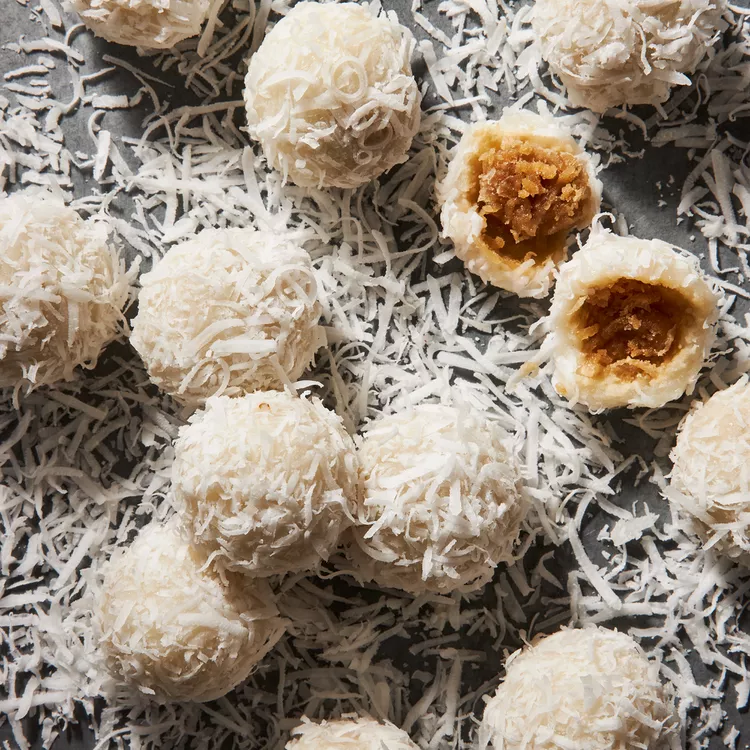
9. Khanom Tom
Khanom Tom is a popular Thai dessert made of soft, chewy rice flour dumplings. These small balls are filled with sweet shredded coconut and palm sugar.
The dumplings are boiled until they float to the surface, indicating they’re cooked. They’re then rolled in fresh coconut flakes for extra flavor and texture.
You can find Khanom Tom in various colors. Some versions use pandan extract for a green hue, while others incorporate purple or orange sweet potato for natural coloring.
This dessert is often served during Thai festivals and special occasions. It’s a tasty treat that showcases the use of coconut, a key ingredient in many Thai sweets.
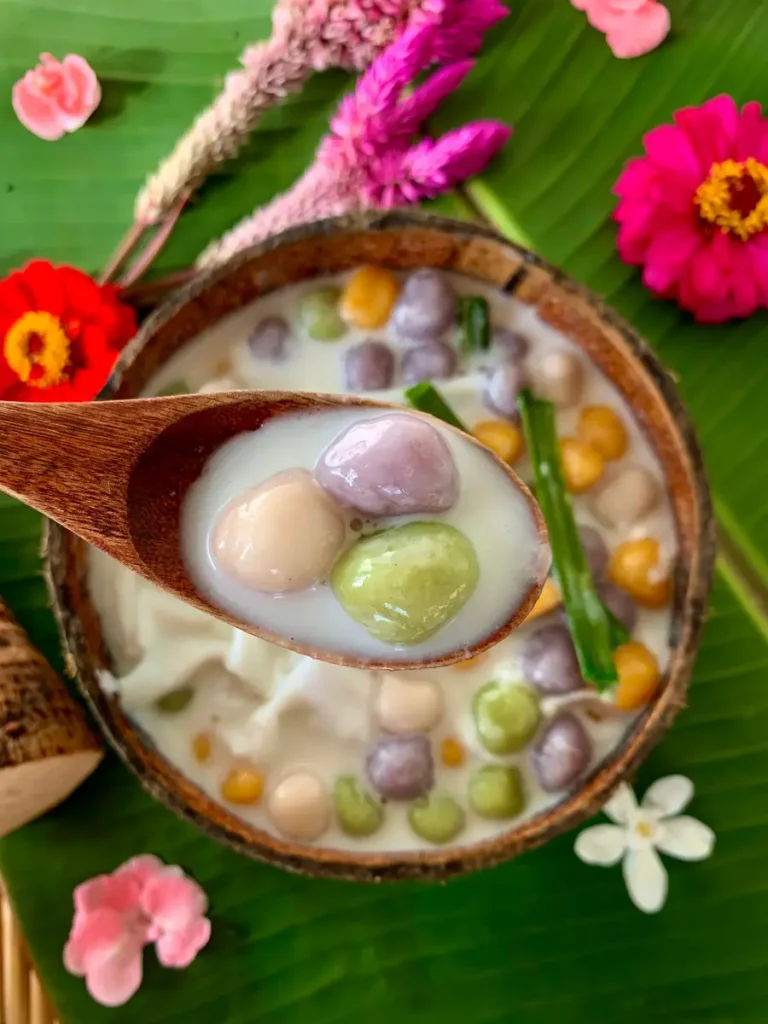
10. Bua Loy
Bua Loy is a popular Thai dessert made of small rice balls in sweet coconut milk. You’ll love the chewy texture of these colorful little dumplings.
To make Bua Loy, mix glutinous rice flour with water to form small balls. Cook these in boiling water until they float, then transfer them to a pot of warm coconut milk sweetened with sugar.
Some recipes add pandan leaves for flavor and aroma. You can also crack eggs into the warm coconut milk for extra richness.
Bua Loy comes in various colors, often made by adding natural ingredients like taro or pumpkin to the rice flour dough. This dessert is best served warm and makes a comforting treat on cool evenings.
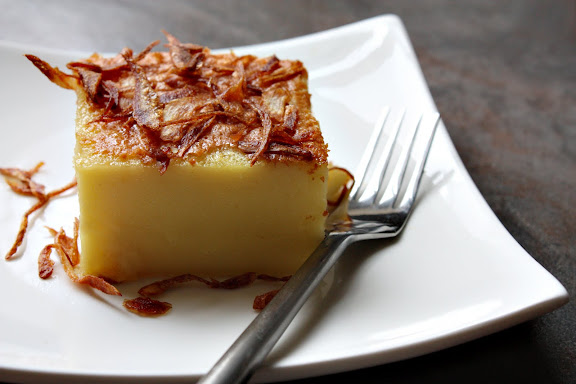
11. Khanom Mo Kaeng
Khanom Mo Kaeng is a traditional Thai custard dessert you’ll love. It combines sweet and savory flavors in a unique way.
The main ingredients are coconut milk, eggs, palm sugar, and salt. Shallots fried in oil add a savory touch on top.
You’ll find this dessert has a rich, creamy texture similar to flan. It’s typically baked until set and has a golden brown color.
Khanom Mo Kaeng dates back to the 1700s in Thailand. It’s stood the test of time and remains popular today.
You can enjoy this treat warm or at room temperature. It’s a great way to end a Thai meal or as a sweet snack.
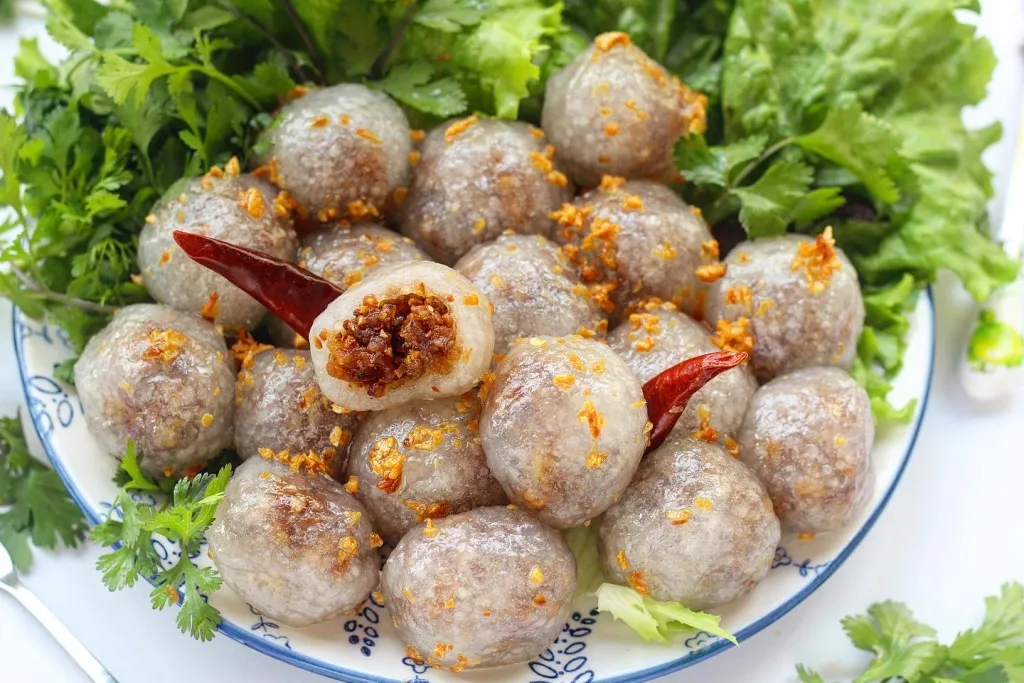
12. Saku Sai Moo
Saku Sai Moo is a unique Thai dessert that combines sweet and savory flavors. It features small, chewy tapioca pearls stuffed with a seasoned pork filling.
The tapioca pearls are made from a mix of white and green varieties, giving the dessert a visually appealing look. The pork filling is typically seasoned with garlic, palm sugar, and other spices.
To make Saku Sai Moo, you first prepare the tapioca pearls and let them cool. Then, you stuff them with the pork mixture and steam the dumplings until cooked through.
Before serving, you can brush the dumplings with garlic oil for extra flavor. Fried garlic is often sprinkled on top as a garnish.
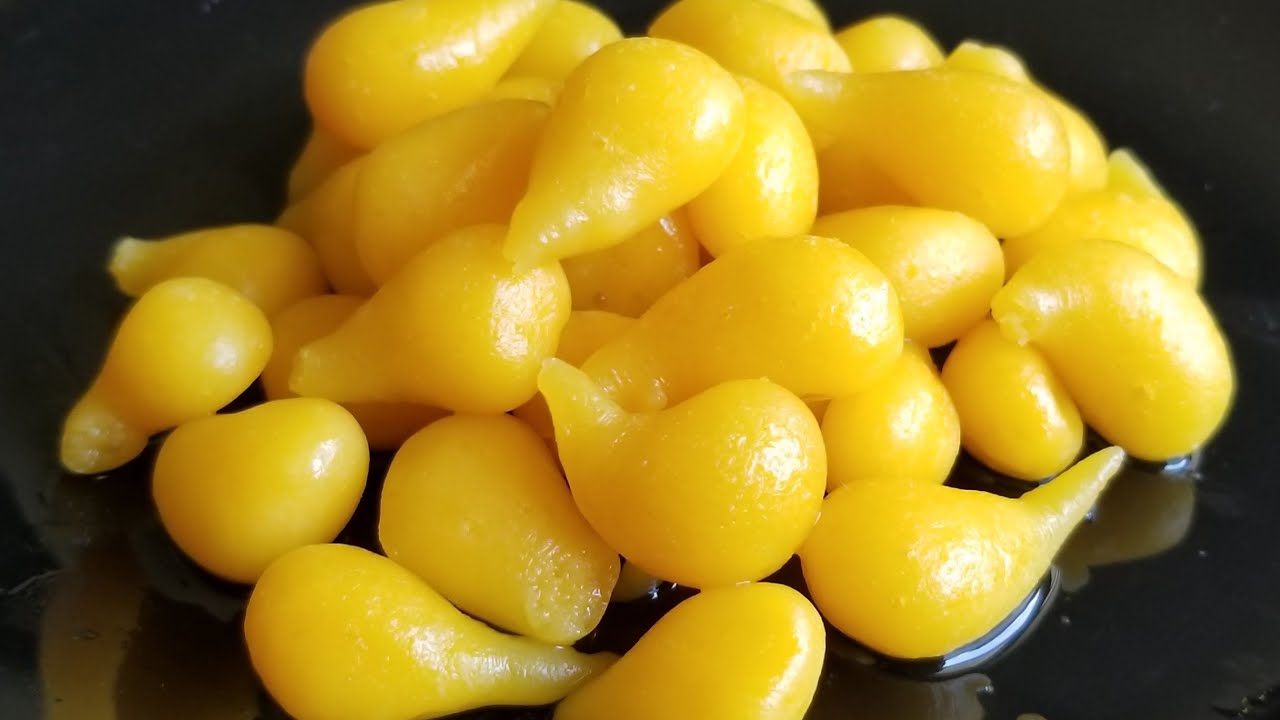
13. Thong Yod
Thong Yod is a golden Thai dessert shaped like small teardrops. It’s made from egg yolks and sugar syrup, giving it a rich, sweet flavor.
You’ll often see Thong Yod served at important ceremonies and celebrations. Its golden color symbolizes wealth and good fortune.
To make Thong Yod, egg yolks are mixed with a bit of flour. This mixture is then dripped into hot syrup, forming small drops that cook quickly.
The result is a smooth, silky treat with a delicate texture. When you bite into Thong Yod, you’ll taste the sweet syrup and creamy egg flavor.
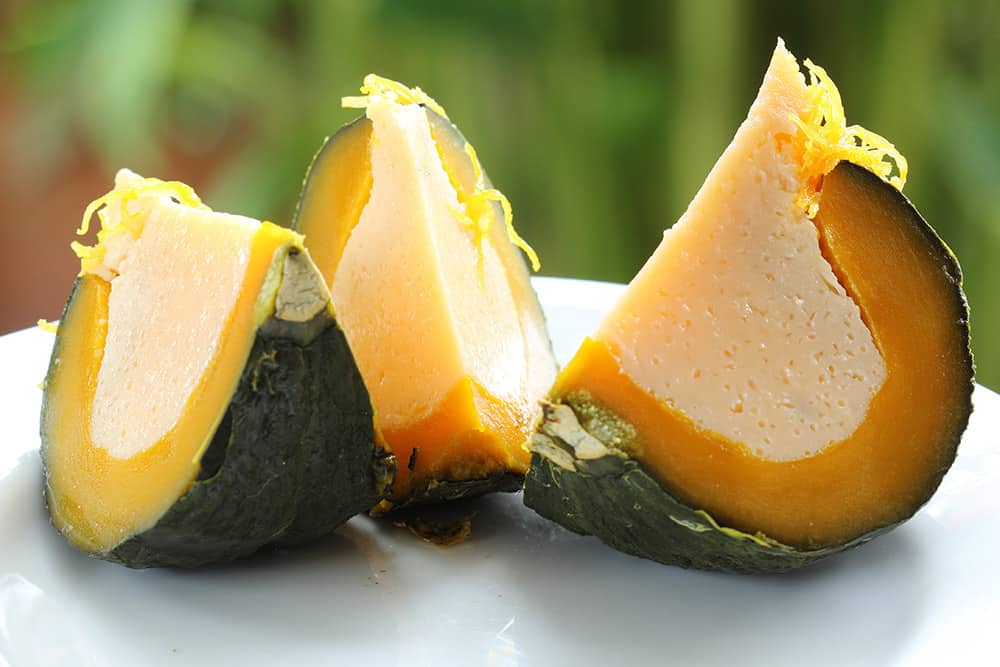
14. Sangkhaya Fak Thong
Sangkhaya Fak Thong is a delightful Thai dessert that combines pumpkin and coconut custard. You’ll love this unique treat that’s both visually appealing and tasty.
To make it, you hollow out a small pumpkin and fill it with a rich custard mixture. The custard typically contains coconut milk, eggs, sugar, and sometimes pandan for flavor.
You then steam the filled pumpkin for about 45-60 minutes until the custard sets. Once cooled, you can scoop out spoonfuls of the sweet custard along with tender pieces of pumpkin.
This dessert offers a perfect balance of flavors and textures. The smooth, creamy custard pairs wonderfully with the slightly firm pumpkin flesh. It’s a must-try for anyone exploring Thai sweets.
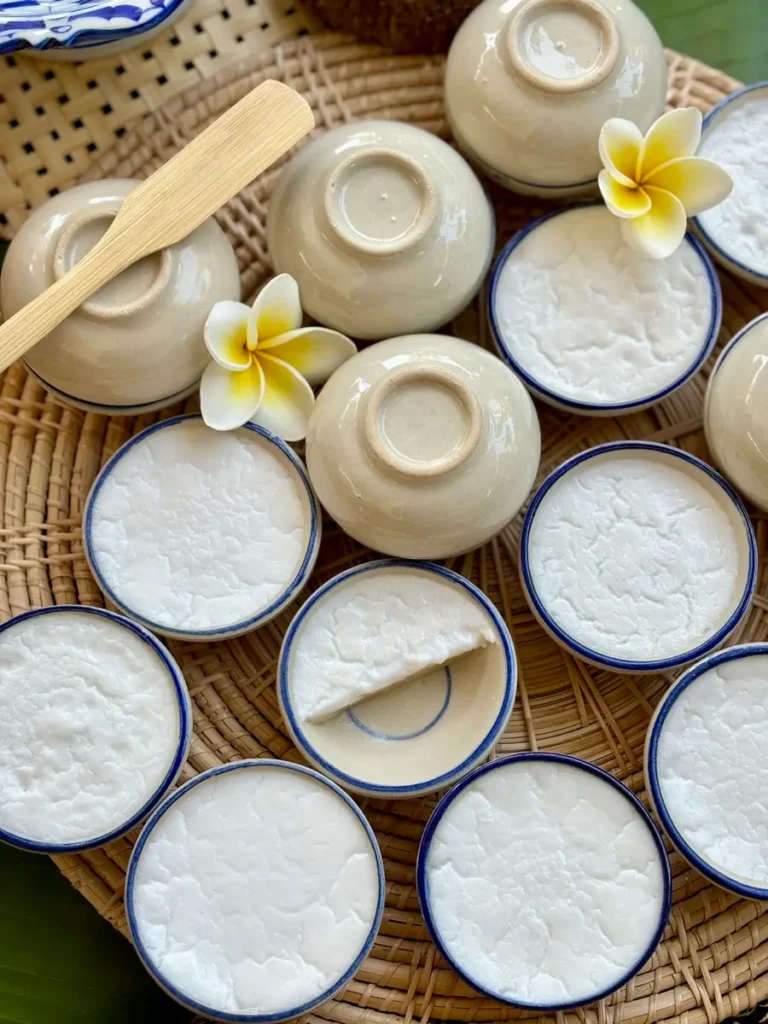
15. Khanom Tuay
Khanom Tuay is a popular Thai coconut custard dessert. You’ll find it served in small porcelain bowls, which gives it its unique presentation.
This sweet treat has two layers. The bottom layer is made from rice flour, coconut milk, and sugar. The top layer is a creamy coconut milk custard.
To make Khanom Tuay, you steam the dessert in small bowls. First, you cook the bottom layer until it sets. Then you add the top layer and steam it again.
The result is a soft, creamy dessert with a slightly firm bottom. It’s not too sweet and has a rich coconut flavor that you’ll love.
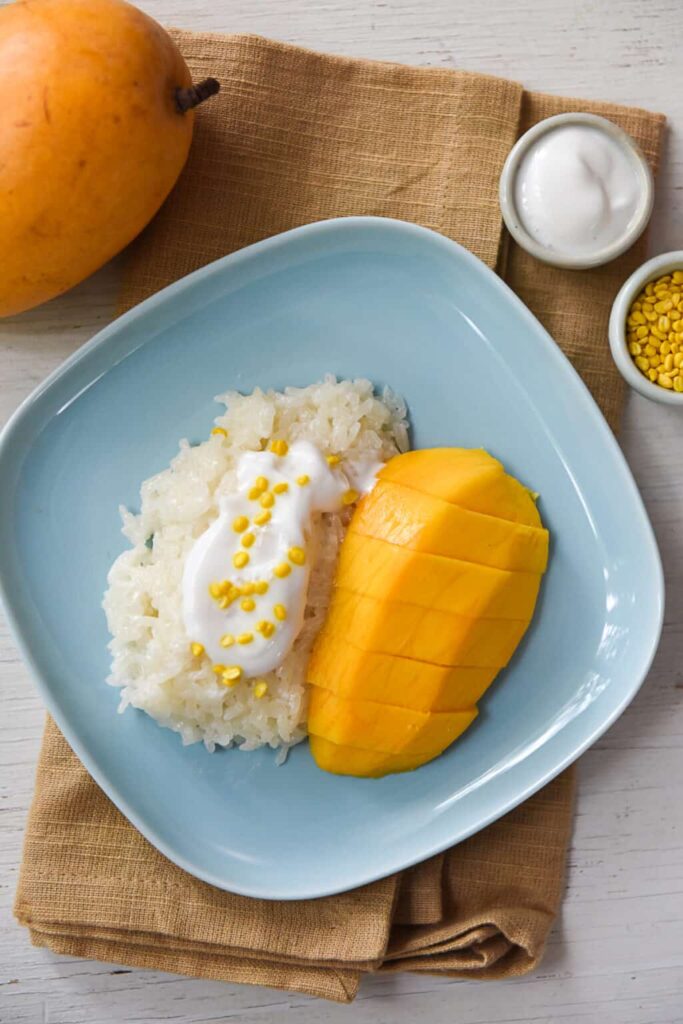
16. Khao Niew Na Muang
Khao Niew Na Muang is a beloved Thai dessert that combines sweet sticky rice with ripe mango. You’ll find this treat enjoyed all over Thailand, especially during mango season.
The dish starts with glutinous rice steamed to perfection. It’s then mixed with sweetened coconut milk, giving it a rich, creamy texture.
Served alongside the sticky rice are slices of juicy, yellow mango. The contrast between the warm, sweet rice and cool, tangy fruit creates a delightful balance of flavors and textures.
Some versions include a drizzle of extra coconut cream sauce on top, adding even more indulgence. You can find Khao Niew Na Muang at street stalls, markets, and restaurants throughout Thailand.
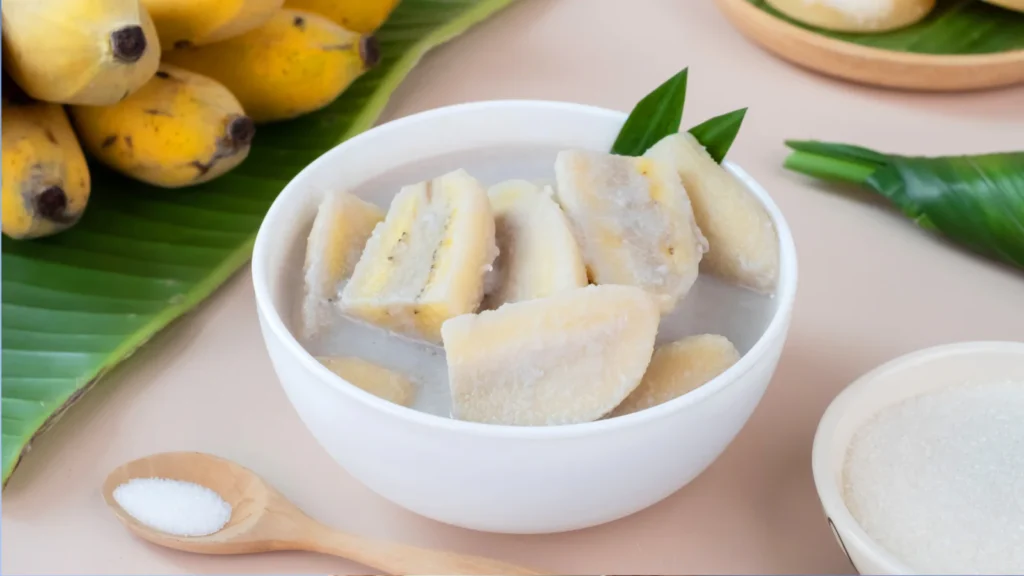
17. Kluay Buat Chi
Kluay Buat Chi is a simple yet delicious Thai dessert. You’ll love this sweet treat made with bananas and coconut milk.
To make it, you cook ripe bananas in coconut milk with a bit of sugar and salt. The bananas become soft and absorb the creamy coconut flavor.
Some recipes add pandan leaves for extra aroma. You can serve this dessert warm or chilled. It’s easy to make and perfect for when you want a quick, tasty treat.
Kluay Buat Chi is both comforting and nutritious. It’s a great way to use up ripe bananas and enjoy a taste of Thai cuisine at home.
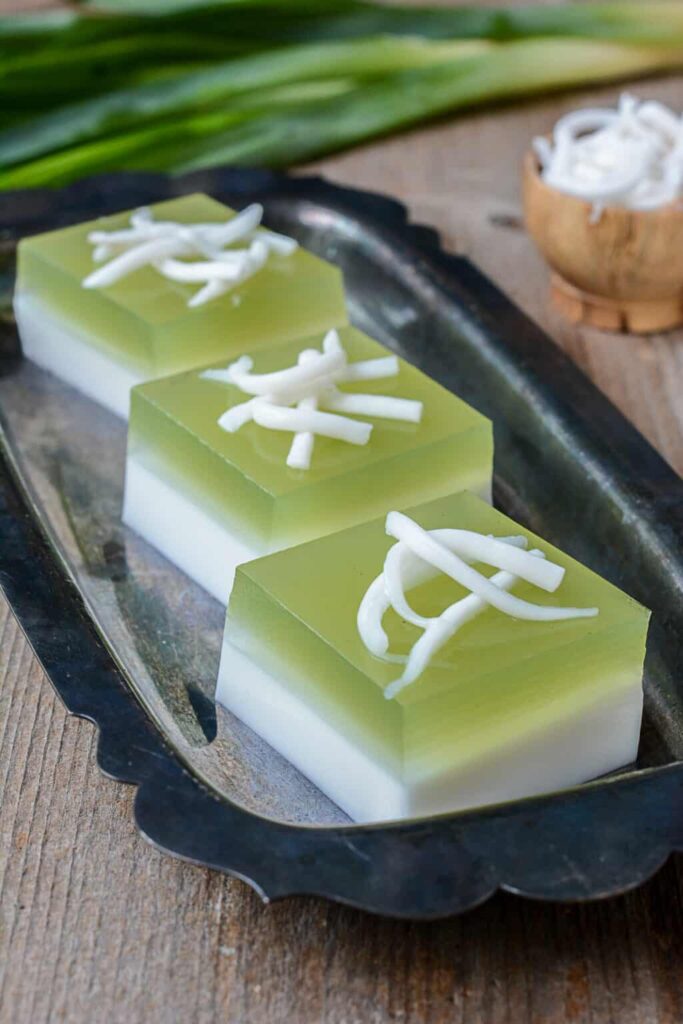
18. Wun Gati Bai Toey
Wun Gati Bai Toey is a popular Thai dessert that will delight your taste buds. This refreshing treat features layers of coconut and pandan jelly, creating a beautiful green and white pattern.
To make it, you’ll need agar agar powder, coconut milk, pandan extract, and sugar. First, you create the pandan layer by mixing agar agar with water, sugar, and pandan extract. Then, you make the coconut layer using coconut milk and agar agar.
The dessert is typically served chilled, making it perfect for hot days. Its creamy texture and tropical flavors offer a satisfying end to any meal. You can find Wun Gati Bai Toey in many Thai restaurants or try making it at home for a fun cooking project.
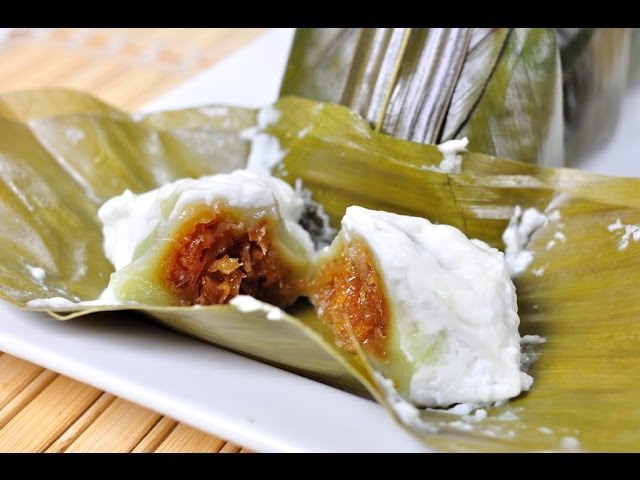
19. Khanom Sod Sai
Khanom Sod Sai is a sweet Thai treat you’ll want to try. It’s made of small rice balls filled with tasty ingredients.
The rice balls are crafted from glutinous rice flour. They’re soft and chewy, giving a nice texture to the dessert.
Inside, you’ll find delicious fillings like peanut butter or chocolate. This mix of flavors and textures makes each bite interesting.
Khanom Sod Sai is perfect for a quick snack between meals. You can find it easily in Bangkok and other parts of Thailand.
When you visit Thailand, make sure to look for this dessert. It’s a great way to experience local flavors and satisfy your sweet tooth.
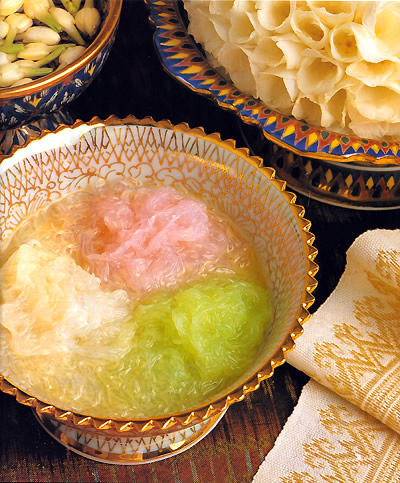
20. Sali
Sali is a sweet Thai dessert made from rice flour and coconut milk. You’ll love its soft, chewy texture and delicate flavor.
To make sali, mix rice flour with coconut milk and sugar to form a dough. Shape the dough into small balls or ovals.
Then boil them in water until they float to the surface. Serve the sali warm in coconut milk with a sprinkle of grated coconut on top.
This simple treat is popular at Thai festivals and celebrations. You can enjoy sali as a snack or light dessert any time. Its mild sweetness makes it a favorite with both kids and adults.
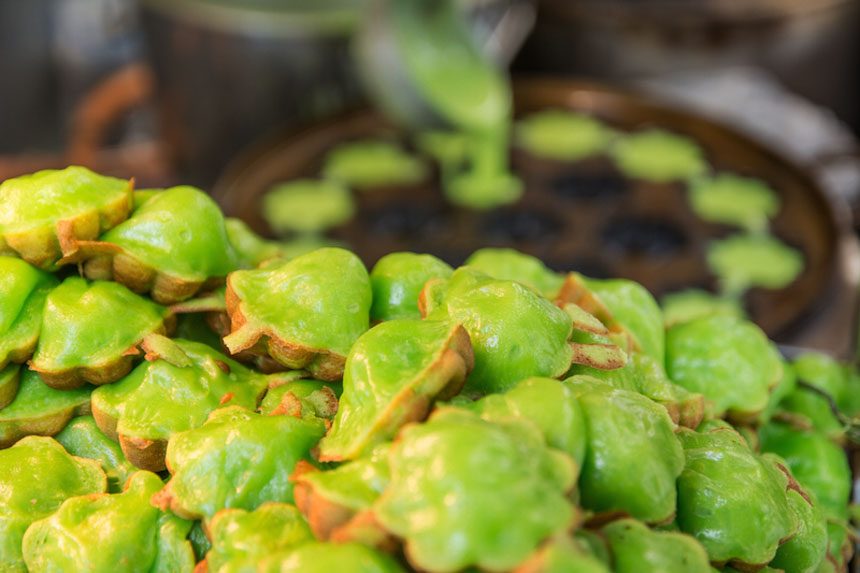
21. Kanom Krok Bai Toey
Kanom Krok Bai Toey is a tasty Thai dessert that combines coconut and pandan flavors. You’ll love its crispy edges and soft, pudding-like center.
To make this treat, you mix rice flour, coconut milk, sugar, and pandan extract. Then you cook the batter in a special pan with small round molds.
As the pancakes cook, they turn golden brown on the outside. The inside stays creamy and sweet.
You can top them with coconut flakes or spring onions for extra flavor and texture.
These bite-sized snacks are perfect for enjoying with friends or as a quick dessert. You’ll find them at street food stalls and markets throughout Thailand.
Cultural Significance of Thai Desserts
Thai desserts play a big role in traditions and daily life. They have special meanings and uses that go beyond just being tasty treats.
Traditional Ceremonial Uses
Thai desserts are key parts of many ceremonies. At weddings, couples often serve “khanom tuay foo” – a fluffy dessert that means growth and success. This sweet treat comes in pretty colors and is made with rice flour, sugar, and yeast.
Religious events also feature special sweets. Temples offer desserts like “khao tom mud” (sticky rice with banana) to honor Buddha. During holidays, families make treats to give as gifts or use in rituals.
Birthday celebrations include desserts too. People might eat “bua loy” – sticky rice balls in coconut milk. This dish stands for togetherness and long life.
Symbolism in Thai Culture
Many Thai desserts have special meanings. “Foi thong” (golden threads) stands for lasting love. It’s made by pouring egg yolks into hot syrup to make long, sweet strands.
The number nine is lucky in Thailand. So, there are nine lucky desserts often served at big events. Each one means something good, like wealth or success.
Colors matter in Thai sweets too. Gold or yellow treats mean money and fortune. Green desserts stand for growth. Red sweets are for joy and good luck.
Some desserts look like objects with meaning. “Thong yip” (pinched gold) is shaped like a flower to mean beauty and growth.
Ingredients Commonly Used in Thai Desserts
Thai desserts use unique ingredients that give them their distinct flavors and textures. These components blend sweet, salty, and sometimes savory notes to create tasty treats.
Tropical Fruits
Mangoes are a popular choice in Thai desserts. You’ll often find them in puddings or paired with sticky rice.
Bananas also feature heavily, used in fritters or cooked with coconut milk. Pineapples bring a tangy sweetness to many dishes.
Jackfruit adds a unique flavor and chewy texture to various sweets. Durian, though divisive, is loved by many for its rich, creamy taste in desserts. Lychees and longans offer a delicate sweetness in jellies or as toppings.
Fresh fruits are often used as is, but you might also see them dried or made into pastes for different recipes.
Coconut-Based Ingredients
Coconut is a staple in Thai desserts. You’ll find coconut milk in many recipes, adding richness and creaminess. It’s used in puddings, custards, and as a cooking liquid for sticky rice.
Coconut cream, thicker than coconut milk, is used for toppings and fillings. Shredded coconut adds texture to many sweets. Coconut sugar, made from coconut palm sap, gives a caramel-like flavor.
Here’s a quick list of coconut products used in Thai desserts:
- Coconut milk
- Coconut cream
- Shredded coconut
- Coconut sugar
Flour and Starch Varieties
Rice flour is essential in Thai desserts. It’s used to make dough for dumplings, pancakes, and other sweets.
Sticky rice flour, made from glutinous rice, creates chewy textures in many treats.
Tapioca flour, from cassava roots, is used in puddings and as a thickener. Mung bean flour appears in some recipes, adding a unique flavor and texture.
Pandan leaves are often ground with water to make a paste. This green extract adds color and a distinct aroma to many desserts.
Try these flours in your Thai dessert recipes:
- Rice flour
- Sticky rice flour
- Tapioca flour
- Mung bean flour